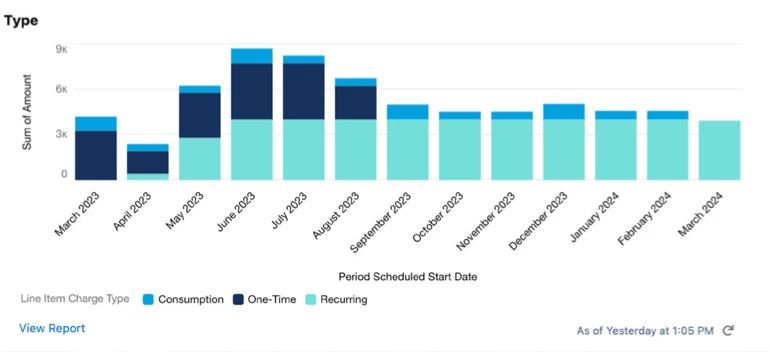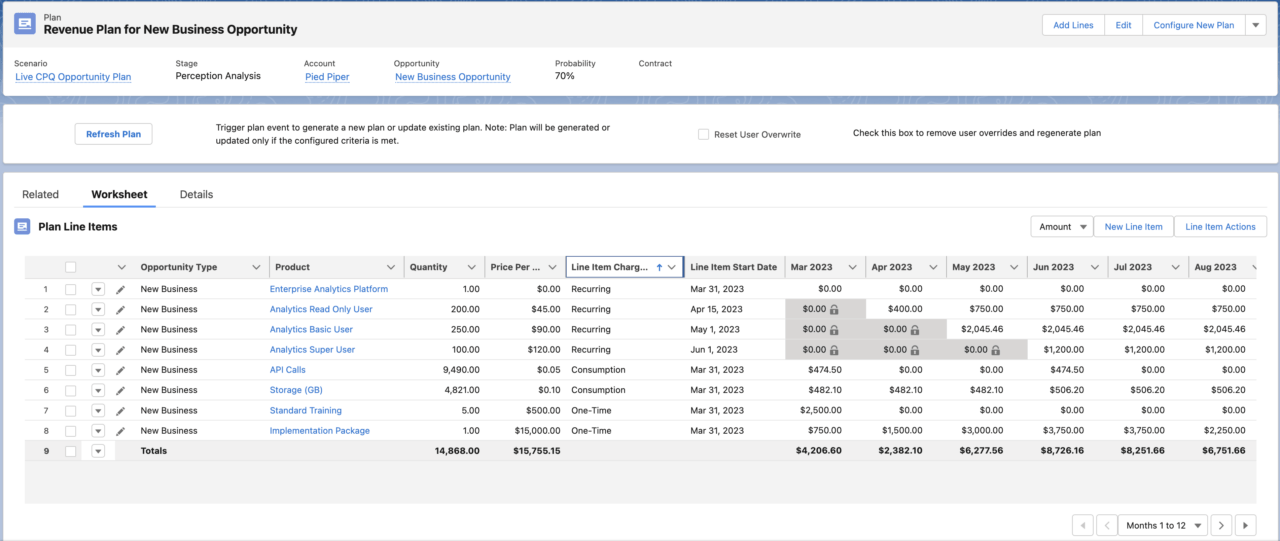How to Boost Revenue by Uniting Sales, Finance, and Ops Teams
Last updated on Friday, August 4, 2023
What This Ebook Will Cover
In today’s fast-paced business environment, aligning sales, finance, and operations teams is crucial for optimizing revenue performance.
Each make big contributions to revenue, but departmental silos and outdated forecasting methods can make collaboration between these departments difficult — and it’s getting worse, not better, with new technology.
This guide will provide insights into the importance of Revenue Operations (RevOps), how to overcome common obstacles, and practical steps to unite departments. With a focus on leveraging Salesforce and other CRM data, you’ll discover how to generate accurate, automatically adjusted forecasts that drive smarter decision-making andboost revenue.
What is RevOps and Why is It Important?
RevOps, or Revenue Operations, is a strategic business approach that unifies and aligns an organization’s marketing, sales, and customer success teams.
The core objective of RevOps is to optimize the entire revenue-generation process, from lead generation to customer retention, by getting all of the departments of an organization working together.
The importance of RevOps lies in its ability to break down traditional silos between departments, fostering a collaborative environment that focuses on common goals. By establishing a single source of truth for data, RevOps streamlines decision-making and creates a more efficient system to drive revenue growth.
Also, RevOps enables organizations to adapt to ever-changing market conditions by using insights to identify trends and opportunities. This approach helps businesses stay ahead of the competition, as they can quickly respond to evolving customer needs and preferences.

How Departments Get Siloed – And the Problems It Causes
It is quite common for departments within organizations to be siloed, which can have a significant impact on a company’s overall performance.
The rise of technology, particularly CRM and ERP systems, has actually made this problem worse: these systems generate valuable data that often remains trapped in silos instead of being leveraged across departments, hindering effective communication and collaboration.
Manual, Inefficient Processes
Aligning multiple departments can be challenging due to existing forecasting processes that are often manual and inefficient, with data existing on many disconnected (and often outdated) spreadsheets. Although some level of collaboration exists, it is typically suboptimal, resulting in incomplete, untimely, and inaccurate forecasts. The core issue lies in the inability of the current systems to communicate effectively.
Inability to Act on Issues
When sales and revenue forecasts are not aligned, inaccurate forecasts and poor guidance for the rest of the company tend to be the results. This issue is especially prevalent in B2B companies, where bookings play a crucial role in revenue generation. Because of this inaccurate information, companies can’t act on critical issues because they don’t know what they are.
Run Rate Revenue Overlooked
In addition to sales, run rate revenue is another critical aspect of a company’s business that is often overlooked due to siloed data. Run rate — which involves account managers predicting how their accounts will change over the next 3-6 months — is hard because it sits outside of the typical sales process, so this data is even more manual than new business forecasts. Traditionally, these run rate forecasts are conducted using spreadsheets and manual processes that are inefficient and insecure.
The Solution: Break Down the Silos
To overcome the problems of siloed departments and inefficient forecasting processes, organizations should focus on the following key strategies:
- Boost communication and collaboration
- Streamline forecasting processes
- Implement more efficient systems
Boost communication and collaboration:
- Improve cross-departmental communication and collaboration.
- Establish a unified data repository accessible to all relevant departments.
- Foster a culture that encourages teamwork and shared goals.
Streamline forecasting processes:
- Replace manual processes with automated tools and systems.
- Standardize forecasting methodologies across departments.
- Continuously evaluate and refine processes for accuracy and efficiency.
- Utilize existing logic from Finance/Ops as part of the streamlining within the sales processes.
Implement more efficient systems:
- Adopt technology solutions that facilitate data sharing and real-time updates.
- Integrate CRM, ERP, and other relevant systems for seamless information flow.
- Utilize data analytics and business intelligence tools to enhance decision-making.
By focusing on these strategies, organizations will not only produce more accurate and timely forecasts but also foster a collaborative environment that drives overall business success.

3 Steps You Should Take to Immediately Start Aligning Departments
Now that you know what the problem is, how can you start to fix it? We recommend these three steps to align departmental data:
Step 1: Compile
The first step is to consolidate and automate data from various departments. Replace manual processes, such as spreadsheets, and integrate the finance and sales data to build a comprehensive view of the forecast. Ensuring data accuracy and accessibility will create a solid foundation for interdepartmental collaboration.
Step 2: Share
The second step is to ensure that the departments continuously update and utilize the data. Encourage teams to share customer management information with the finance team to maintain high-quality, realtime data. By capturing richer data, including product details, regions, and sales teams, organizations can unlock deeper insights and facilitate decision-making.
Step 3: Analyze
Analyze the gaps and drive improvements: Once the data and processes are in place, the third step is to identify gaps and areas for improvement. Analyze the data to determine what’s causing the company to fall short of its goals, and then implement targeted strategies to address these issues. By focusing on continuous improvement, organizations can optimize their performance and achieve better results.

The Next Priority: Better Aligning Sales & Revenue Forecasts
To improve the alignment of sales and revenue forecasts, CEOs, CROs, CFOs, and COOs need to focus on five key improvements that will not only enhance the accuracy and reliability of forecasts, but also help drive better decisionmaking across the organization.
1. Move away from spreadsheets and manual processes
Spreadsheets are commonly used for sales and revenue forecasting but are prone to errors and lack the dynamic capabilities required for accurate forecasting. Organizations should:
- Implement specialized forecasting tools and software to replace manual processes.
- Ensure seamless integration with existing CRM and ERP systems for real-time data access.
2. Foster collaboration between sales and finance teams
A strong partnership between sales and finance teams is crucial for accurate forecasting. Both teams bring unique perspectives and expertise to the table:
- Encourage regular communication and joint meetings to discuss forecasts and performance.
- Establish a clear understanding of each team’s roles and responsibilities in the forecasting process.
3. Utilize dynamic forecasting techniques
Dynamic forecasting adjusts to changes in the business environment and market conditions, providing organizations with the most up-to-date and relevant information:
- Regularly update forecasts based on the latest sales data and market trends.
- Incorporate external factors, such as economic indicators, to understand what customers are doing or planning to do.
4. Leverage the expertise of the finance team
Finance teams possess valuable knowledge about revenue recognition and other critical aspects of the forecasting process. To better align sales and revenue forecasts:
- Involve the finance team in the development and refinement of forecasting models and methodologies.
- Train sales teams on finance concepts to promote a shared understanding of revenue recognition principles.
5. Spend more time analyzing information than creating data
In order to better align sales and revenue forecasts, organizations must prioritize decision-making over simply gathering data:
- Establish a culture that values accurate, timely, and accessible information.
- Utilize advanced analytics and business intelligence tools to gain deeper insights from data.
- Make informed decisions based on comprehensive, forecasts to guide business strategies
By focusing on these key areas, CEOs, CROs, CFOs, and COOs can significantly improve the alignment of sales and revenue forecasts within their organizations. Adopting a collaborative approach and leveraging advanced tools and techniques can help organizations unlock the full potential of their sales and finance teams, driving growth and performance in a competitive market.

Your Salesforce CRM Already Collects All the Data You Need: Here’s How to Use it
CRMs hold a wealth of data that CFOs and COOs can utilize to make informed decisions and improve their organization’s performance. Here are seven steps you should take to extract and utilize key data points and metrics.
1. Track forecast accuracy and growth
Tracking forecast accuracy and growth helps organizations gauge their performance against projections:
- Monitor revenue predictions for the next six months.
- Combine run rate forecasts, existing deals, and new business models for a comprehensive view.
2. Use revenue components and modeling
Understanding the various components of revenue, such as new business and run rate, is crucial for accurate forecasting. CRMs are getting better operational data from things like CPQ, and so it should be leveraged in forecasts:
- Model new business on top of existing run rate and previous deals.
- Adjust pipeline projections based on propensity to close.
3. Examine operational metrics such as units and supply chain
Beyond dollars, operational metrics are vital for understanding supply chain and production needs:
- Track the number of units to be manufactured and shipped.
- Monitor supply chain fluctuations and adapt strategies accordingly.
4. Don’t stop at the booking
The ability to manage forecasts after the deal closes ensures you are getting the revenue that was committed at the time of sale:
- Compare sold revenue with expected and realized revenue.
- Adjust forecasts based on past discrepancies between sales and finance projections.
5. Monitor key performance indicators (KPIs)
Identify and track KPIs relevant to your organization’s goals and objectives:
- Track KPIs such as customer acquisition cost, customer lifetime value, and sales cycle length.
- Regularly review KPI performance to identify areas for improvement.
6. Automate data extraction and analysis
Take advantage of automation to streamline data extraction and analysis processes:
- Implement automated reporting and dashboard tools to provide real-time insights into Salesforce CRM data.
- Set up alerts and notifications to stay informed about changes in key metrics.
7. Train teams on data interpretation
Your team has access to richer and more accurate data that allows you to fully leverage business intelligence and analytic tools, so you must take advantage of that. Ensure that all team members understand how to interpret and use Salesforce CRM data effectively:
- Provide training on data analysis and interpretation techniques.
- Foster a culture of continuous learning and improvement.
By fully utilizing the data available in your Salesforce CRM, company leadership can better align sales and revenue forecasts, optimize operational efficiency, and ultimately drive business growth.
Embracing a approach to decision-making can help organizations gain a competitive edge in today’s rapidly evolving market landscape.

How to Get Accurate, Automatically Generated Forecasts With Ease
Navigating today’s dynamic market landscape requires accurate and up-to-date revenue forecasts to drive informed decision-making.
But even with a unified RevOps team, it’s not easy to compile all this data and turn it into accurate, actionable revenue forecasts.
RevVana was created specifically to unite sales and finance teams, ensuring they stay in sync with revenue forecasts that automatically adjust as your business evolves. By breaking down departmental silos, streamlining forecasting processes, and utilizing the wealth of data within your Salesforce CRM, revVana empowers organizations to make smarter, decisions.
Here’s how revenue forecasting looks in revVana. This sample chart shows how we help businesses visualize their future revenue — months and even years into the future.

Navigating today’s dynamic market landscape requires accurate and up-to-date revenue forecasts to drive informed decision-making.
But even with a unified RevOps team, it’s not easy to compile all this data and turn it into accurate, actionable revenue forecasts.
RevVana was created specifically to unite sales and finance teams, ensuring they stay in sync with revenue forecasts that automatically adjust as your business evolves. By breaking down departmental silos, streamlining forecasting processes, and utilizing the wealth of data within your Salesforce CRM, revVana empowers organizations to make smarter, decisions.
Here’s how revenue forecasting looks in revVana. This sample chart shows how we help businesses visualize their future revenue — months and even years into the future.
Key benefits of revVana include:
- Automatic generation of accurate revenue forecasts
- Real-time adjustments based on dynamic market conditions and changing customer preferences
- Enhanced collaboration between Sales, Finance, and Operations teams
- Easy integration with Salesforce data
Don’t let outdated forecasting methods hold your organization back. Experience the power of revVana’s cutting-edge forecasting solution and embrace the future of accurate, revenue predictions. Elevate your organization’s performance and unlock its true potential with revVana today.
You Can Enhance Your Salesforce Revenue Forecasting Now
Are you tired of inaccurate revenue forecasts costing your company millions of dollars? Don’t let manual processes and human error stand in the way of your organization’s success. Take action today to enhance your Salesforce revenue forecasting and make smarter, decisions that will help you stay ahead of the competition.
RevVana Salesforce Revenue Forecasting can help your organization achieve these goals by automating and streamlining revenue forecasting in Salesforce, providing real-time insights on CRM data, and reducing manual errors. With RevVana, you can instantly translate forecasts in the pipeline and closed opportunities into forecasts of revenue streams. This will help you make more informed business decisions and stay ahead of the competition.
Don’t wait any longer to take action – contact revVana today to learn more about how we can help you enhance your Salesforce revenue forecasting capabilities and achieve your revenue goals. Our team of experts will work with you to create a customized solution that fits your unique needs and helps you achieve success. Take the first step towards accurate revenue forecasting with RevVana today.

How to Boost Revenue by Uniting Sales, Finance, and Ops Teams
Published on Friday, August 4, 2023

